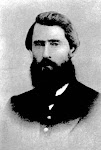She left for Oregon with a small second wave of missionaries sent in 1836 to aid Jason Lee in Salem. Did she possibly become aware even as she left, that by engaging into that work he began, she would also engage her life with his?
From "Jason Lee's Prophetic Vision," the eulogy of Hon. W. D. Fenton[1]:
And here I may be permitted to pay a word of tribute to the woman who gave her life as a sacrifice to the work of Jason Lee. By the courtesy of Miss Anna Pittman, a niece of Anna Maria Pittman, the first wife of Jason Lee, I have been permitted to read several autograph letters written by Mrs. Lee before she was married and while she was preparing to come to Oregon. In her last letter of date June 9, 1836, written from New York to her brother, George W. Pittman..., she says:I have taken my pen in hand to address you for the last time. The time is drawing nigh when I must bid a long farewell to all I love. I quit the scene of my youth, the land of my birth, and in a far and distant land among strangers I expect to dwell. Soon the rolling billows of the tempestuous ocean, and the towering mountain's rugged steep, will intervene between us, and perhaps we see each other's faces no more. As the hour approaches for my departure, I still remain firm and undaunted; I have nothing to fear, God has promised to be with me even to the end of the world. Dear brother, farewell, may Heaven bless you, and oh remember your sister who goes not to seek the honours and pleasures of the world, but lays her life a willing sacrifice upon the altar of God.
This letter written in a bold and firm hand and signed Anna Maria Pittman breathes the spirit of the martyr. In a postscript to the letter she says:In the ship Hamilton we leave Boston the 1st of July. The mission family will be in this city the 20th of June when a farewell missionary meeting will be held. We will leave sometime that week. The number is nine, five are females, three are married.
She came and paid the sacrifice with her life. She was married to Jason Lee on the 16th day of July, 1837, not far from where Salem now stands. She died on the 26th of June, 1838, and is buried in the old mission cemetery. In that sacred spot where we are about to re-inter all that is mortal of Jason Lee lies buried the wife of his youth and the infant son for whose birth her life was a sacrifice, the first white child born in the state of Oregon, the first white woman married, and as Mr. Gill has so well said, "The first to die in the Oregon Country." Upon her tombstone you will read today at Mission Cemetery, Salem, these words: "Beneath this sod, the first ever broken in Oregon for the reception of white mother and child, lie the remains of Anna Maria Pittman Lee." This man and this woman together will sleep at last. The work which they did has outlived them. She in her sphere, and he in his performed well their part. Jason Lee was by birth, education and training a devout enthusiast and loyal patriot and the prophet of a new state. His life illustrates again the truth of the statement that to achieve success there must be a single purpose, and energies must not be wasted or dissipated in attempting to do well more than one thing.
There is always room for a man of force and he makes room for many. Society is a troop of thinkers and the best heads among these take the best places. A feeble man can see the farms that are fenced and tilled, the houses that are built. The strong man sees the possible houses and farms. His eye makes estates as fast as the sun breeds clouds.
 This photo is from the centennial celebration in Salem, Oregon, in July, nineteen-hundred and forty. Oliver Huston portrays Reverend Jason Lee and Mrs. O. K. Paulus portrays his wife, Anna Maria Pittman. Source: Salem, Oregon Public Library Historic Photograph Collections
This photo is from the centennial celebration in Salem, Oregon, in July, nineteen-hundred and forty. Oliver Huston portrays Reverend Jason Lee and Mrs. O. K. Paulus portrays his wife, Anna Maria Pittman. Source: Salem, Oregon Public Library Historic Photograph Collections1. Lee, Jason. "Memorial Services at Re-internment of Remains of Rev. Jason Lee." Salem: Salem Public Library, 1906; pp.16-17.















